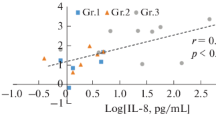Abstract
There is criticism that the major line of evidence regarding posttraumatic inflammatory response and bacterial translocation has mainly come from experiments in rodents. The aim of this study was therefore to investigate the very early bacteremia/endotoxemia and inflammatory response in nonhuman primates.
Six baboons were subjected to hemorrhagic shock (40 mm Hg mean arterial pressure) preceded by infusion of zymosan-activated plasma (to simulate trauma-associated complement activation) followed by reinfusion for 1 h. Measurements of complement and granulocyte (PMN) activation, cytokines of the inflammatory network, soluble cytokine receptors, and bacteria/endotoxin translocation (BT) were performed.
There were significantly increased levels of PMN elastase, interleukin-6, and soluble tumor necrosis factors (TNF) receptors, but not of TNF. BT was evident from positive blood cultures, and from trendwise increased endotoxin plasma levels. Early liver damage was shown from elevated glutathione S-transferase (GST) plasma levels.
Complement activation and hemorrhagic shock lead to an early inflammatory response together with bacteremia/endotoxemia as evidence of translocation from the gut already during the shock period in subhuman primates.
Similar content being viewed by others
Author information
Authors and Affiliations
Additional information
Received: June 6, 2000; revision accepted: October 23, 2000.
Rights and permissions
About this article
Cite this article
Redl, H., Bahrami, S., Fürst, W. et al. Evidence for Early Bacteremia/Endotoxemia and Inflammatory Responses after Trauma – Hemorrhage and Complement Activation in a Nonhuman Primate Model. Eur J Trauma 26, 300–307 (2000). https://doi.org/10.1007/PL00002455
Issue Date:
DOI: https://doi.org/10.1007/PL00002455




